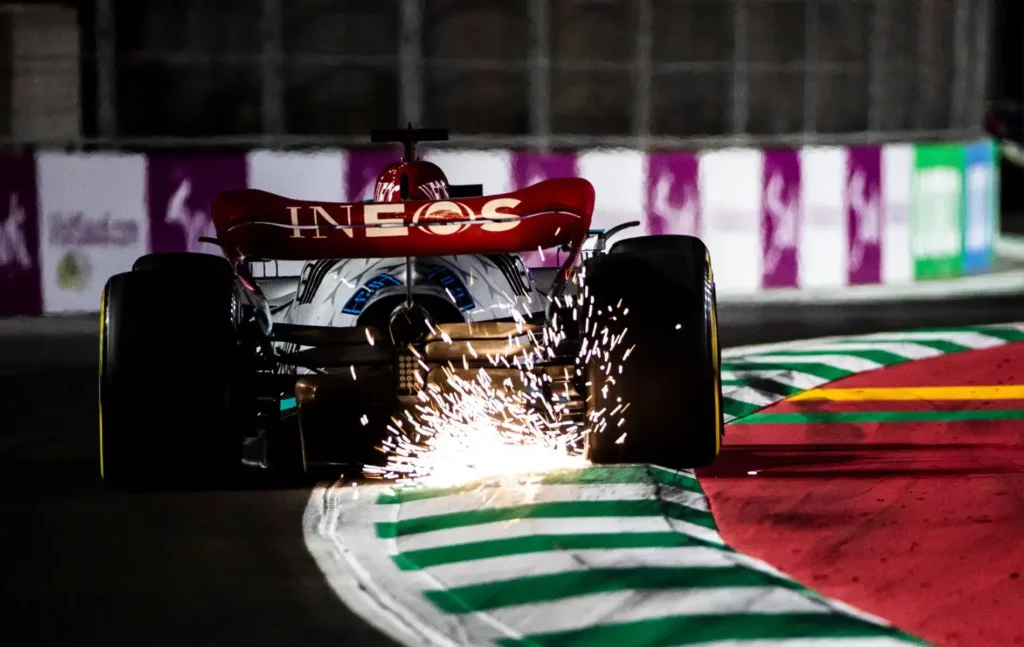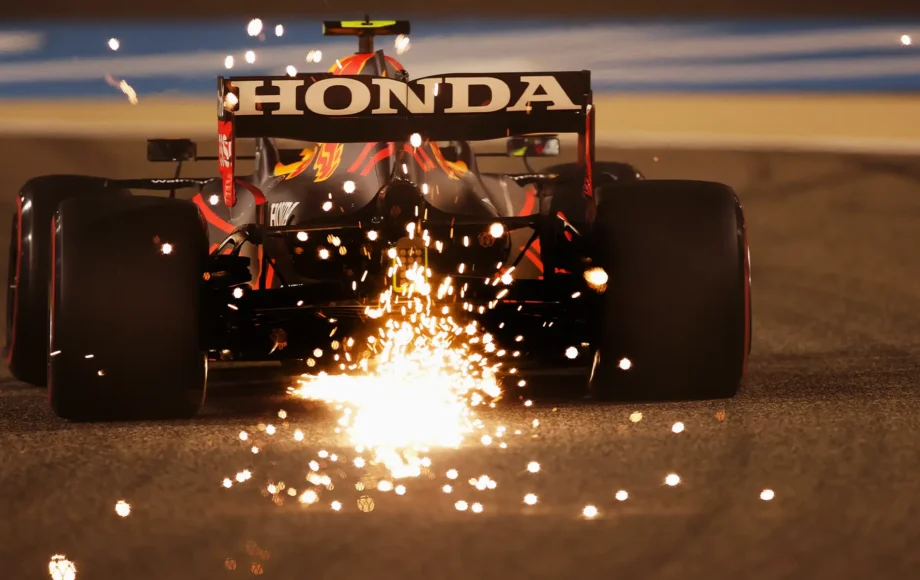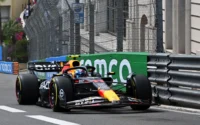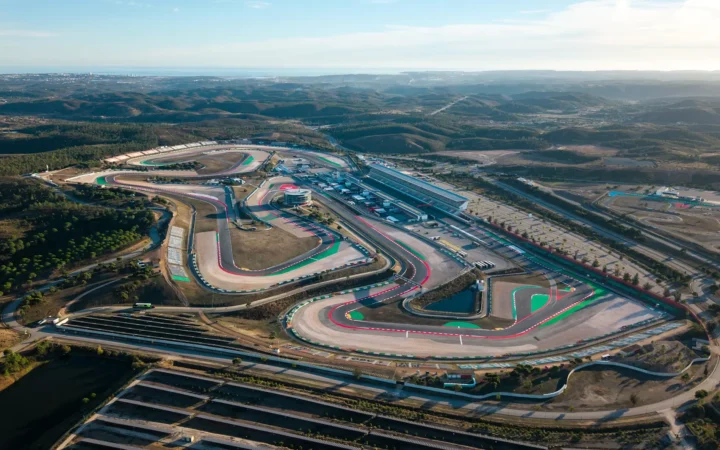The image of a Formula 1 car showering sparks has captivated F1 fans for decades, from the 80s to today. Not only is it visually stunning, but it raises questions about why they produce these sparks.
What to know
- A unique component, a plank/skid block underneath the car, produces sparks.
- Rule changes have influenced sparks throughout the years. Following the tragic death of Ayrton Senna at the 1994 Imola Grand Prix, the FIA imposed new regulations for skid blocks.
- Sparks are not only harmless but are a display of how the car is functioning correctly.
The answer lies beneath the car, where a titanium skid block hits the track. The incredible speeds of an F1 car generate an immense amount of downforce, sucking the car to the track’s surface, making contact, and creating sparking. The effect is most visible on night races, particularly on high speed straights and corners where the downforce is highest.
Why do Formula 1 cars spark?
As explained, sparks are produced by a unique component called a plank or skid block. This part of the car is located underneath, secured to the floor, and extends from the vehicle’s rear to just before the front wheels. The low ride height of F1 cars means that during moments of “bottoming out” — when the car’s lowest part touches the ground — these skid blocks scrape against the track surface, creating a shower of sparks.
Initially, they were made of a type of hardwood called Jabroc. However, as technology evolved, F1 teams began experimenting with more advanced materials to optimise the durability and performance of the skid block. These skid blocks are limited to protrude no more than 3mm, to ensure minimal and controlled contact with the track.
Today, the FIA (Fédération Internationale de l’Automobile) mandates that skid blocks must be made from a bi-composite material, typically including a carbon fibre composite surface for strength and titanium for its wear-resistant properties. The combination of these materials ensures the skid block can withstand the incredible stresses and temperatures it’s subjected to during a race while also being light enough not to affect the car’s performance.
| Material | Characteristics | Benefits |
|---|---|---|
| Carbon Fiber | Lightweight, high tensile strength | Enhanced structural integrity |
| Titanium Alloys | Durable, heat-resistant | Improved heat dissipation |
| Advanced Polymers | Flexible, impact-absorbing properties | Increased shock resistance |
The plank also serves a dual role. First, it helps reduce the car’s underbody aerodynamics. Second, it aims to prevent the car from bottoming out on straights and maintain the car’s ride height within safe limits.
As a car is pushed closer to the ground due to aerodynamic forces, it generates more downforce. This increased downforce increases the likelihood of the skid blocks making contact with the track, particularly in sectors involving high-speed corners, straights, and areas where the elevation of the track changes.
A history of sparks and F1
In the late 1980s, sparks became a hallmark of Formula 1 as teams focused on aerodynamics and lowered their cars to maximise downforce. It was most noticeable in the early laps of a race when the fuel load was high or on tracks with a bumper surface.
A great example was from the 1991 season at the Spanish Grand Prix in a duel between Nigel Mansell and Ayrton Senna. Mansell, after the race, admitted to intentionally driving over bumps to create sparks and distract trailing drivers.
In 1994, following the tragic death of Ayrton Senna at the Imola Grand Prix, the FIA intervened with new regulations including rules on skid blocks. To reduce the higher speeds of F1 cars, teams were required to have a 10mm thick skid block or plank on their floor so they weren’t run too low. A wear limit of 1mm was set for the plank, with any more leading to disqualification as seen with Michael Schumacher at the 1994 Belgian Grand Prix and Jarno Trulli at the 2001 United States Grand Prix, although Trulli’s team successfully appealed.
The 2000s saw a noticeable decline in sparks where tungsten skid blocks were used, but in 2015, the FIA switched to titanium skid blocks to enhance safety and revive the spectacle of sparks. Before 2015, teams had been experimenting with durable metals on the plank to lower their cars, which had led to sparking when the car bottomed out. However, this posed safety risks, as metal fragments could cause tyre punctures. The switch to titanium was driven by its lighter, safer nature and its faster wear rate.
Why is titanium used as skids on Formula 1 cars?
Titanium’s wear rate is more uniform than tungsten, as it degrades evenly rather than breaking off in hazardous fragments. With increasing speeds, the risk posed by tungsten debris was significant, making titanium a safer and more obvious alternative for the FIA in 2015.
However, titanium’s quicker wear rate presents teams with a strategic challenge. Since titanium doesn’t last as long as tungsten, teams have to manage their car’s ride height to avoid excessive wear. If not carefully monitored, the titanium skid block can wear down too quickly, leading to the car’s wooden plank being worn away below the allowed limit and risking disqualification. In 2023, we saw Lewis Hamilton and Charles Leclerc at the 2023 United States Grand Prix being disqualified for such a rule infringement.
Titanium, while safer than other materials, is also known for generating more sparks, so it was also chosen to enhance the visual experience of F1, particularly in night races like those in Bahrain, the Abu Dhabi Grand Prix, and Singapore, which add to the drama and excitement for fans.
Do sparks damage F1 cars?
Sparks often give the impression of a mechanical issue or damage to the car. However, these sparks are not only harmless but are a display of how well the car is performing.
Produced by the titanium skid block, they are designed to shield the wooden plank underneath from excessive wear and damage. The plank is part of the car’s design, acting as a regulatory feature to prevent teams from setting the car’s ride height too low.
While the sparks do not damage the car, they can occasionally cause minor burn marks on the driver’s visor or bodywork. However, these are generally superficial and not a cause for concern. The materials used on an F1 car are designed to withstand high temperatures so sparks won’t compromise the safety of the car or driver.
Why are F1 cars so low to the ground?
Sparks are a byproduct of the cars running extremely close to the ground, a design choice to enhance their performance. This low ground clearance lowers the centre of gravity, which helps the cars respond quickly to a driver’s input. When combined with the car’s aerodynamic elements like wings, this generates higher downforce.
Downforce is a critical concept in F1 racing. Unlike aeroplanes, which use their wings to lift off the ground, F1 cars use their aerodynamic components — including the wings, floor, diffuser, and bodywork — to exert a downward force. This force effectively pushes the car onto the track, increasing grip, especially during cornering. Technically speaking, an F1 car generates enough downforce to drive upside down in a tunnel. This increased grip allows for higher cornering speeds, although it requires considerable engine power to overcome the additional aerodynamic resistance.
Why do F1 cars spark more on the straights?
On straight sections of the track, cars hit their highest speeds. As the speed increases, so does the downforce on the car. This greater downforce means the car presses closer to the ground, increasing the likelihood of the car’s floor contacting the track, especially when encountering bumps or, through the natural responses a ground effect car has through bouncing.

This changes slightly during cornering. As the cars slow down to make a turn, the downforce they experience decreases. Naturally, as the car breaks, it will rise slightly, increasing the clearance between the plank and the circuit, leading to fewer sparks. However, sparks can still happen during cornering, mainly when a car goes over a curb. The car’s floor scratching against the curb can generate sparks.
Tracks and sections where F1 cars spark the most
F1 cars generate significant sparks during elevation changes when the track rubs against the ground. Notable examples include the famous Eau Rouge corner at Spa-Francorchamps, Belgium, various sections of the Autodromo Jose Carlos Pace in Brazil, and the first sector at Japan’s Suzuka Circuit.
The Red Bull Ring in Austria, known for its elevation changes and sharp curbs, especially in the third sector, is another great venue for witnessing F1 cars sparking. Similarly, the Monaco Grand Prix circuit is a hotspot for sparks with its constant elevation changes and bumpy street layout.
Night races further amplify the visibility of these sparks. Throughout the F1 calendar, night races have been held at circuits that include Las Vegas, Jeddah, Singapore, and Abu Dhabi.
Each of these circuits, with its unique layouts and surfaces, creates various degrees of speaking.
Conclusion
Altered in 1994 as an added safety feature, the creation of sparks has evolved into one of the most distinctive elements of Formula 1 racing. Far from indicating issues with a car, the sparks are a byproduct of the car’s design that ensures it races within the regulations while adding an extra layer of excitement for fans.
For more F1 Terms, check out our F1 Glossary, covering everything from DRS and G-force to oversteer, slipstreaming, tyre warmers, and turbulence. This guide offers clear explanations of the most frequently used F1 terms. You’ll be speaking the language of Formula 1 like a seasoned fan in no time.
Seen in:






